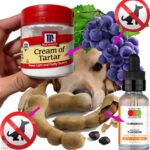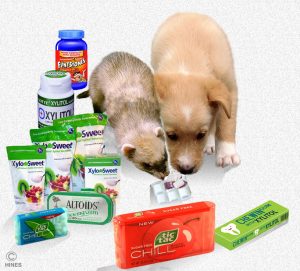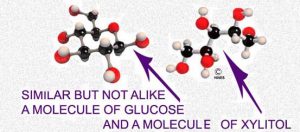 Grape Poisoning In Dogs + Tartaric Acid?
Grape Poisoning In Dogs + Tartaric Acid?
 Antifreeze Poisoning In Your Dog Or Cat
Antifreeze Poisoning In Your Dog Or Cat
Xylitol Sweetener – A Danger To Your Pet’s Health
Ron Hines DVM PhD
Over the last dozen or so years, the sugar substitute, xylitol, has become a common ingredient in commercial food products. Xylitol is made from wood and other types of cellulose, (although small, harmless, amounts are found naturally in fruit). It is a popular sugar alternative in baked goods, deserts, toothpaste, candy and sugar-free gum. It is a popular sugar substitute for diabetics and for weight loss programs. Although xylitol is as sweet as table sugar, it has one third fewer calories. Its mild antibacterial properties make it a popular cavity-fighter in chewing gums and toothpaste. You might easily have a xylitol-containing product in your home without even realizing it.
Although xylitol consumption appears to be harmless in humans, that is not the case in dogs. Dogs handle this sugar substitute differently. They absorb it more rapidly, it affects their insulin and blood sugar levels differently, and it predisposes them to liver damage not seen in humans that consume xylitol. As the popularity of xylitol in human food increased the incidence of accidental xylitol poisoning in dogs began to increase too.
What About Sorbitol?
Despite their similar names and sweet taste, sorbitol consumption by pets is unlikely to cause more than transient diarrhea and flatulence.
How Common Is Xylitol Poisoning?
Although the number of xylitol-related poisonings has increased over the years, xylitol is not among the top ten poisoning dangers for dogs in the United States. Accidental consumption of human prescription medications tops that list. That is followed by insecticide exposure, lawn and garden products, over-the-counter pain-relieving medications like ibuprofen/Advil™/Motrin™, chocolate, assorted household cleaning products, overdoses of veterinary medications, rat and mouse killer consumption, various toxic houseplants and automotive products. (read here) In the UK, human over-the-counter pain medications also tops the list, followed by rat and mouse baits, chocolate, acetaminophen/paracetamol/Tylenol™ insecticides, slug killer (metaldehyde), lilies (cats only), grapes, electronics batteries and, within their range, adder bites.
Does Xylitol Affect All Kinds of Pets The Same Way?
No
Different species of animals absorb and metabolize xylitol differently. In some, it causes blood insulin levels to go up and blood sugar levels to become critically low. In other species, no toxicity of that nature occurs. For example, the lethal dose (LD50) of the caffeine in coffee in mice is 367 mg/kg, whereas the lethal dose of xylitol in mice is about 12,500 mg/kg.
In home situations, xylitol is primarily a dog problem. I know of no reports of xylitol causing toxicity in cats when ingested orally. I do not know if that is because cats absorb and metabolize xylitol differently than dogs or because the taste of xylitol appeals to cats less. Xylitol was actually once tried as an additive to cat drinking water in an effort to decrease tartar formation – although at levels too low to form conclusions as to its effect on the cat’s blood sugar level.
What Happens When My Dog Eats Xylitol?
If you consume xylitol, your body absorbs it slowly, and when that occurs, your body recognizes that it is not table sugar. Once your body has converted all the real table sugar (sucrose) in the things you eat into glucose, your pancreas releases insulin to metabolize that sugar and remove excessive amounts from your blood stream.
But when your dog eats xylitol, this sugar substitute enters its blood stream much faster and, unlike your body, your dog’s body does not recognize that xylitol is not true table sugar. So, your dog’s pancreas releases a large amount of insulin to deal with it. This causes a sudden and sometimes severe drop in your dog’s blood sugar level (hypoglycemia), similar to what diabetics experience if they accidentally take too much insulin. How severe depends on how much xylitol was eaten by the dog, and perhaps other things such as what else is in the dog’s stomach at the time and how long it took whatever the xylitol-containing product was to dissolve. The classical symptoms of hypoglycemia in humans are weakness, confusion, tremors, twitching, staggering and even seizures. Those are exactly the same symptoms you could see in your dog. If the amount of xylitol was small, it is possible that all you would see is less interest on the part of your pet in interacting with you and its environment (lethargy), perhaps some loss of appetite, vomiting and/or diarrhea. Poison control centers have also found that there is a great deal of variation in how a similar dose of xylitol affects individual dogs. Enlarge the next diagram to see how similar the sugar and the xylitol molecules are:
What Are Some Of The Products In My Home That Might Contain Xylitol?
The list is very long and product ingredients change from time to time, but various brands of chewing gum, toothpaste, diabetic cookies, mints, specialty breads and baked goods, and products marketed as suitable for people with diabetes often contain xylitol. So can “low-cal” brands of peanut butter and yogurt. Check the ingredients label of these products carefully. Words that would alert you to be particularly cautious would be “Sugar Free”, “Dental”, “Diabetic Approved”, “Dietetic” “diet” or “Low or Reduced Calorie” (if sold in the United States, the word xylitol must be on the package label of xylitol-containing products somewhere even if the print is very small).
Baked goods containing xylitol are particularly troublesome because dogs up to mischief can consume large product amounts. They are also troublesome because they utilize powdered pure xylitol that can be added in excessive amounts by small-scale specialty bakers and because the spongy, crumbly nature of baked goods leads to rapid absorption of the xylitol.
How Much Xylitol Does It Take To Make My Pet ill?
Any consumption or suspected consumption of xylitol is reason enough to visit your veterinarian to have things checked out. You could be wrong about the amount consumed, you or I might be wrong in my calculations or your pet might react to the xylitol ingestion in unanticipated ways.
Veterinarians generally believe that dogs that eat more than 45 mg per pound (100 mg/kg) of their body weight are in danger of a sudden drop in their blood sugar level (a regular size aspirin is 325 mg). One teaspoon full of one leading manufacturer’s (Global Sweet) pure xylitol weighs close to four grams (4000 mg). So, a 20-pound dog might need to eat one-quarter teaspoon full of pure xylitol powder to potentially become ill. Data on the amount of xylitol in things like sugar-free gum are much harder to obtain; but Trident Original™ chewing gum is said by its manufacturer to contain about 170 mg of xylitol per stick. Eating 4-5 sticks of gum could cause problems in a 20-pound dog. Other brands, like Orbits Spearmint, Peppermint and Lemonfresh contain more xylitol – about 285 mg/1.9 gram stick. Other veterinarians have said that as little as one-and-a-half sticks of xylitol chewing gum can be injurious to a ten-pound dog.
When it comes to how much xylitol it takes to injure your pet’s liver, things are even less clear. The amount is definitely more than what it takes to make your pet’s blood sugar level drop – probably five to ten times as much. But there is much more dog-to-dog variability in the degree of liver damage that occurs – and some dogs go on to develop liver problems without first experiencing dramatic changes in their blood sugar levels.
You might detect a degree of uncertainty in what I have told you about how much xylitol is or isn’t dangerous to your dog. That is because the data has never been confirmed experimentally. It is based on sporadic (occasional) cases that are reported to the ASPCA pet poison control center and its counterpart in the UK. In those cases, the conditions under which the pet consumed the xylitol, timing in its relationship to the food in its stomach, variations in the dog’s breed, age and general health, and, most importantly, the owner’s rough estimate of how much product the dog may have consumed are all open to errors. So, we might be erring on the side of caution – as medical people tend to do. Before 1965, research scientists in the Western World would simply have forced a known amount of xylitol into experimental research dogs and seen what happened. Those sort of studies are no longer performed. However, in China, a uniform group of Pekingese dogs were intentionally given 1 or 4 g/kg of xylitol. If the report is accurate, none of the dogs died and no mention is made of liver damage.
What About Veterinary Products That Show Xylitol As One Of Their Ingredients?
Pet dental hygiene products sometimes list xylitol as a minor ingredient. When consumed in the amounts suggested on the package, they pose no known health threat.
How Long Would It Take Xylitol To Affect My Dog?
When a dog consumes xylitol, the effects generally begin in 20- 30 minutes. The Chinese study found that the blood insulin level in these dogs was already rising in 20 minutes and peaked at 40 minutes. US studies have found that those rising insulin levels cause the dog’s blood sugar to begin to drop about a half hour after it eat the xylitol-containing product. The form the xylitol and the foods already present in the dog is in can also have an influence in how fast it is absorbed from the pet’s digestive system. That may account for a few cases in which the fall in blood glucose levels was delayed. How long the pet’s blood sugar stays critically low is also quite variable – so blood sugar levels might need to be monitored for an entire 24-hour period (longer if the xylitol is gradually being released from some confectionery product that dissolves slowly).
If My Dog Ate Xylitol, What Are The Signs and Symptoms I Might See?
None of the signs you might see would tell you for certain that xylitol was the problem – short of finding missing food items or torn packaging. But the first signs of ingestion are the typical signs of low blood sugar (hypoglycemia). A few dogs vomit, but that is not a consistent sign. Dogs suffering the effects of low blood sugar levels become less coordinated. They progress from apathy and disinterest in their surroundings and owner to depression. Depending on the amount consumed that can progress to collapse and even seizures. Some dogs develop diarrhea.
Dogs that ingest large amounts of xylitol have a second more serious risk – in a substantial percentage of them, their livers sustain substantial damage. Although the biochemical signs of that damage (a rise in blood liver enzyme levels) begin early, it can take a number of days for the full extent of that liver damage to become apparent. At that point, the signs can be no more than lingering abnormalities in the pet’s liver enzymes in mild liver damage all the way up to the signs of complete liver shut down and acute hepatic (liver) failure. Dogs generally have to eat more than 500-1,000 mg/kg body weight of xylitol to be at risk of those severe signs. As with hypoglycemia, there is a great deal of variability in how severe the effects will be with any given dose. It is also not that uncommon for dogs to go on to liver damage without first showing signs of prior hypoglycemia (low blood sugar). Signs that a pet’s liver is in trouble are vomiting, disinterest is food, yellowing of the skin, gums and eyes, increased bleeding and slowing of the blood’s ability to clot.
What First Aid Can I Administer On My Way To My Veterinarian?
Dogs that are not fully in control of their mental and physical capacities should not be induced to vomit. That is because they may well inhale food and stomach contents into their lungs in the process of heaving.
So if you can make it to the veterinarian in 15-20 minutes or less – just go there.
But if you are in a remote location, and your dog appears completely alert, you can often cause it to vomit back much of the xylitol-containing material it ate if it has been less than 30 minutes since it ate it. The best, readily available product to do this is 3% hydrogen peroxide solution. It must be a fresh bottle – a drop of which will “frizzle” on your tongue – and it must not be the strong kind used to color hair, etc. If the dog will eat, hydrogen peroxide works best on a full stomach –something spongy like bread. The accepted dose is 1 teaspoon or 5 ml per 10-15 pounds of body weight. But I usually give only a teaspoon full to a 30-50 pound dog and wait to see if that is not sufficient – less than a teaspoon full for toy breeds. I limit the total amount to three teaspoons full regardless of weight. A dog that is beginning the upchuck process usually begins to salivate, foam and heave in 5-15 minutes. The hydrogen peroxide can be repeated. It might also be advisable to give frequent small amounts of oral sugar solution (to a fully conscious dog) if no veterinarian will be available.
If two hours or more have passed since the pet ate the xylitol, inducing it to vomit is unlikely to help as the stomach contents have usually moved too far down the intestine to be regurgitated (upchucked). (If no veterinarians are available in your part of the world, you might consider giving pets that are still fully lucid frequent small meals and oral sugar.)
How Will My Veterinarian Diagnose A Xylitol Problem In My Pet?
None of the signs of xylitol toxicity are specific – they could all be caused by a number of other health conditions. So, veterinarians can easily overlook the possibility if you, the owner, does not hint that the dog ate a product that is known to contain xylitol or that the dog has a history of eating things that it shouldn’t. Trash can raiding dogs are so common. But many dog owners are too embarrassed to let their veterinarian in on that secret.
When the cause of symptoms is not obvious on a physical examination or through the dog’s history, most veterinarians begin their workup with an analysis of a sample of your pet’s blood. The red flag result for xylitol (if sufficient time has passed) is a lower than normal blood glucose level. When the amount of xylitol consumed was substantial a liver enzyme (ALT) and blood bilirubin usually rise as well. (ref) Blood thrombocyte numbers might drop and tests that measure the rapidity with which your dog’s blood clots might become abnormally long (prothrombin time, partial thromboplastin time, clotting time). The pet’s blood potassium, phosphorus and calcium level might also be abnormal as well. If the poisoning occurred a number of days prior to admission and the amount consumed was substantial, evidence of abnormal bleeding (bruising, nose bleeds, bloody stool or vomit) and liver failure could be present as well.
Are There Other Health Problems That Might Cause Similar Signs?
Yes
There are other things that can cause sudden, unexplained drops in blood sugar and weakness. Insulin injection overdose or consumption of human anti-diabetic medication, insulin secreting tumors of the pancreas (insulinomas – pancreatic beta cell tumors), failure to eat adequately or frequently enough, a dysfunctional liver, insufficient cortisone (Addison’s disease) could all present themselves with similar signs.
Later signs related to liver damage could be confused with acetaminophen (Tylenol®) poisoning, consumption of rat or mouse poison, and more rarely – ingestion of liver-toxic plants like poisonous mushrooms, moldy grains (aflatoxins), algae-contaminated water, infections like leptospirosis or toxoplasmosis or certain cancers.
How Will My Veterinarian Treat My Dog?
Your veterinarian might induce your dog to vomit if not too much time has passed. Your vet might also give the dog a universal antidote containing charcoal (although there are doubts as to its effectiveness against xylitol). Some vets attempt to wash out the pet’s stomach (gastric lavage) when dogs arrive soon enough after consuming the xylitol.
Early in a xylitol poisoning case, your veterinarian will be dealing with or anticipating a serious drop in your dog’s blood sugar level. Your veterinarian will attempt to correct or minimize that by administering a slow, intravenous solution of glucose with frequent monitoring of the pet’s blood sugar level. The same blood samples used to monitor the pet’s blood sugar level will probably also be checked for abnormalities in blood potassium (hypokalemia) and phosphorus (hyper or hypophosphatemia)– the two components that are commonly affected. Close monitoring allows your vet to add whatever support is necessary to keep the pet comfortable. Vomiting and indigestion can be controlled with a number of medications (e.g. metoclopramide, famotidine, sucralfate).
Once your veterinarian has your pet hooked to an IV drip (intravenous infusion of liquid) and your pet’s blood sugar levels are no longer critically low, the vet will probably turn attention to the more worrisome later side effect of eating xylitol. That effect is liver damage.
Liver damage due to xylitol ingestion is highly unpredictable. It will occur in one dog, but not in another that eats the same amount. In some dogs, it will be severe and resistant to treatment, in others mild and transient. In many others, it will not occur at all. But the greater the amount of xylitol your pet ate, the more likely it is that its liver will be affected. Blood test values your veterinarian will be particularly interested in are its ALT, bilirubin and AP levels. The vet will also closely observe your dog for signs that liver damage has affected the ability of its blood to clot. At the slightest indication that the pet’s liver is in danger, and often as a precautionary measure before signs even begin, veterinarians often begin administering medications that are thought to perhaps protect the liver (SAMe, silymarin, N-acetylcystine and vitamins C and E). There is not much science to confirm that they are effective, but veterinarians always want to do everything within their power and our options at that point are quite limited.
If your pet’s blood no longer clots as it should, blood plasma or blood products can be given in an attempt to correct that. Vitamin K1 is often given as well.
Liver problems due to xylitol take longer to assess and resolve than low blood sugar. While dogs get “out of the woods” in a day or so with respect to their blood sugar levels (hypoglycemia); their livers need to be monitors for at least 2-6 days. If there are signs of liver damage, your vet might suggest a lower protein or liver-protective diet for a while.
In many cases, you may have brought your dog to your veterinarian not knowing what was the cause of its sudden illness. As I mentioned, without clues from you, your vet may be perplexed too. So do not be surprised if your veterinarian administers many other medications to protect your pet from many of the conceivable causes for the symptoms he/she is observing when your dog first comes in.
Will My Pet Recover?
Dogs that consume small to moderate amounts of xylitol usually recover with no lasting injuries. Veterinarians have good ways to manage dangerously low blood sugar until the pet’s insulin levels return to normal. But if the dog is brought to the vet already in a coma, experiencing severe hypoglycemic seizures or if during a seizure or violent vomission, food from its stomach was inhaled into its lungs its outlook is more clouded.
Dog that develop liver damage (hepatotoxicosis) due to xylitol are at a much greater risk for death. Your pet’s liver has remarkable capabilities of regeneration; but that requires that some of its liver cells were spared the toxic effects of the xylitol. Only time and supportive care will tell us that. It is also clear that the livers of some dogs are damaged more by the same dose of xylitol than others. But once your pet’s liver tests start to return to normal levels, the dog should be coming home soon.
What About Pet Ferrets?
There is one online report I know of describing poisoning of a ferret that consumed xylitol. That report states that it occurred subsequent to the ferret eating Tic Tacs®. The only Tic Tacs sold in the USA that I know of that contained xylitol were the mentholated Chill Exotic Cherry variety. They are the ones to the forefront of the composite photo at the top of this page. None of the Tic Tac mints sold in my town contained xylitol. However, several competing brands did contain xylitol. To the best of my knowledge, no cases of xylitol poisoning in ferrets were reported to the ASPCA poison control site or the UK. The Italian makers of these mints did not answer my inquiry. Since younger ferrets are very prone to eat things they shouldn’t, it is surprising that there has been only one report. I have had ferret patients develop sudden, fatal liver damage (similar to that described in that one ferret) – long before xylitol was a common food ingredient. In those cases, the ferrets had eaten urethane caulking that had not fully cured.
You are on the Vetspace animal health website
Visiting the products that you see displayed on this website help pay the cost of keeping these articles on the Internet.


